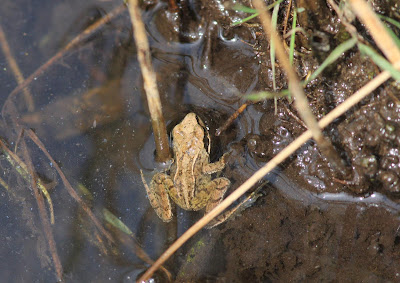I try to like Farmoor Reservoir, I really do but so often it is such a let down. It has all the charisma of a Motorway Service Station but still holds an ongoing attraction both to birds and birders. The hours wasted wandering its miles of soul-less concrete finding very little or nothing do not bear recounting and yet it does have its good days and good birds. I recall Bonaparte's, Sabine's and Franklin's Gulls, American and White winged Black Terns, a Long tailed Skua and even a male Surf Scoter amongst others occuring here but such times and birds are very much in the minority.
I still go there every so often, ever hopeful, and let's face it if there are no birds it can be quite social as there is a good chance of meeting most of the other regular Oxonbirders at one time or another. I can only admire and wonder at the persistence of Dai and Nick Hallam who visit virtually on a daily basis.They are obviously made of stronger mental fortitude than myself.
It's just all that concrete stretching for miles and miles. I pretend it is like the sea shore but of course it's not and never will be but irrefutably it does attract good birds. I had one of my optimistic and 'to hell with it' days today so made a visit after work in the early evening. A very strong easterly wind was blowing but the rain front had passed on and there was now bright sunshine. An obvious tight flock of seven Yellow Wagtails fed in the grass by the Thames Water Works and two Common Swifts passed over, high above me, tacking on the gusts of wind with others skimming the water. No sign of any Black Terns but there were up to five Common Terns in amongst the windsurfers and a juvenile Mediterranean Gull was riding the surf with Black headed Gulls in a distant windblown corner of Farmoor One. Two Common Sandpipers decided the crashing surf was too much and flickered low over the waves to the more sheltered far side of the reservoir.
Tripping lightly through the copious goose turds strewn on the path and circumventing the enormous flock of Canada and Greylag Geese on the grassy surrounds I counted the Canada Geese as I passed. Counting the Canada's is a regular occurrence at Farmoor as there is often little else to do and it uses a few more minutes before having to admit it is crap and retreating to Dix Pit to finish the day on a low. I amassed a total of 248 Canada's this time, well 247 to be precise as one was a hybrid. Where is DEFRA when you need them? Why do I get a frisson of excitement when I encounter one of the almost regular exotic goose species in with the garrulous Canada's and Greylags? This time it was a Bar-headed Goose and the nearest to Mongolia this one has ever been is probably the other side of Farmoor Two or an away day to Blenheim Park in Woodstock. Never mind it was nice to see it.

I trudged onwards down the central causeway and then something happened, as occasionally it does, that made all the effort worthwhile. A juvenile Turnstone, ridiculously confiding and possibly never having seen a human until its arrival here, was feeding on the concrete at the water's edge of Farmoor Two, with another juvenile a few metres away. It looked up at me and then carried on about its business heedless of me trying to photograph it. I watched it pass a few feet beneath me and wondered at its travels. Had it come from Greenland or somewhere else far to the North? Flying with its colleague through night skies over foreign lands and trackless seas, unseen, to arrive in Oxford.
Such an exiciting journey and place of birth compared to the mundane, concrete structure it was now gracing. Where would it be going on to? This is the charm of migrant birds especially waders. They bring a sense of unbounded, uncaring freedom and a wonderful mixture of mystery and hint of lands far away. For a few minutes I forgot all about my dismal surroundings, the problems of my human world, my worries and cares. Looking at my fellow but alien inhabitant of this planet I was in my mind transported as the romantic song goes to 'those far away places with strange sounding names' and briefly anything seemed possible.


 |
| Juvenile Turnstone |






























.jpg)





























